|
המטבח הישראלי
ha-mit-bah ha-yis-ra-e-lee Israeli Cuisine The Israeli cuisine is a multiethnic cuisine of Jewish immigrants from all over the world. The three major influences are Mizrahi / Sephardic (North Africa and Arab countries), Ashkenazi (central and Eastern Europe) and Mediterranean styles of cooking. Ashkenazi dishes include chicken soup, schnitzel, chopped liver, gefilte fish and kugel. Mizrahi cuisine includes grilled meats, sweet pastries, rice, stuffed vegetables, pita breads and salads. African dishes include couscous, shakshouka, matbucha, carrot salad and chraime. Sephardic dishes include burekas, yoghurt and taramosalata. Yemenite foods include jachnun, malawach, skhug and kubane. Iraqi dishes include amba, kubbeh, sambusac, sabich and pickled vegetables.
Mediterranean cuisine include olives, wheat, chickpeas, dairy products, fish, vegetables (tomatoes, eggplants, and zucchini) and fresh fruits (kiwis, bananas, grapes, apples, oranges, lemons, grapefruits, figs, and pomegranates).
Many of these recipes and many more are taught in our
free Hebrew Podcasts newsletter.
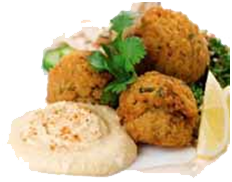  tafritim (pl.), menus.
 Breakfasts include vegetable salad, a variety of soft cheeses such as cottage cheese and yellow cheeses, yoghurt, leben, olives, hard-boiled or scrambled eggs, pickled and smoked herring, a variety of breads, and fresh orange juice and coffee or tea. The North African Shakshouka is made with fried eggs in tomato sauce, and other vegetables.
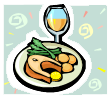 Israeli lunch is the heavier meal of the day and is typically served between 1pm and 2pm. The meal usually have three parts: appetizers - salads or soups, main dish - chicken, meat and fish are served with side dished such as rice, potatoes, and cooked vegetables, and dessert – fruits, ice cream or cake.
 Israeli supper is similar to dinner but is a light evening meal, like breakfast, and is typically served between 7pm and 8pm.
 manot rishonot (pl.), first courses. First courses are usually soups, salads or appetizers.
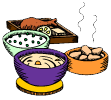 manot eekariyot (pl.), main courses. Main courses are usually chicken, meat or fish with side orders such as potatoes, rice or noodles like spaghetti.
 manot ahronot (pl.), desserts. Desserts are usually cakes, puddings, ice cream or fruit. A compote is an Israeli dessert made from fruits that are cooked in juice.
 mitavnim (pl.), appetizers. Memoolaeem are meat- and/or rice-stuffed vegetables such as stuffed vine leaves or artichoke bottoms. Moroccan cigars are fried stuffed meat phyllo-dough. Iraqi kubbeh is bulgur stuffed with ground lamb and pine nuts. Falafel, the symbol of Israeli food, are fried patties of spiced, mashed chickpeas or fava beans. Jews from Turkey brought burekas that are flaky dough topped with sesame seeds, and filled with cheese, spinach, potatoes or mushrooms.
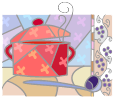 marakim (pl.), soups. Chicken soup, sometimes called Jewish penicillin, is cooked with chicken and vegetables such as onion, carrot and celery and served with soup croutons (shkedei marak). On major holidays it is also served with matzah balls (kneidalah). Lentil soup is cooked with cilantro and/or meat. The Moroccan spicy soup harir is cooked with lamb or chicken, chickpeas, lentils and rice. The Yemenite ftut is a soup cooked with bone marrow.
 Israeli salad is made with chopped tomatoes and cucumbers with olive oil, lemon juice, salt, pepper and minced parsley.
Eggplant salad, baba ghanoush (salat hatzilim), is made with grilled eggplants mashed with tahina, garlic, and lemon juice or mayonnaise. Israeli avocado is added to other salads or is spread on bread. Other salads include Turkish salad (chopped onions and tomatoes), tabbouleh, Moroccan spicy carrot salad, marinated roasted red peppers, and matbucha.
 bsarim (pl.), meats. Beef and lamb kabab and shishlik can be grilled or barbecued (mangal). These are meats that Israelis love to make outdoors while picnicking in parks and forests, usually on Yom Haatzmaut. Meat patties (ktzitzot) are fried and cooked with tomato sauce. The shawarma is a Turkish dish of lamb roasted on a rotating skewer, shredded and stuffed in a pita. Hamin (tshollnt) is a traditional Jewish meat stew with potatoes, beans and barley simmered overnight and eaten usually on the Sabbath.
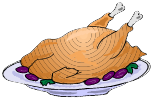 ofot (pl.), chickens. Chicken is the most popular meat in Israel and can be oven-roasted with potatoes. The Moroccan style is chicken casserole with couscous. The Mediterranean chicken is made with olives. The Sephardic style is chicken with albondigas (dumplings) in tomato sauce. Central European Jews brought schnitzel which is fried, breaded chicken.
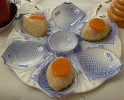 dagim (pl.), fish. Fresh fish are caught off the coast of Israel or raised in ponds. Mediterranean fish is served whole with lemon juice. Examples of fish are trout (forel) and gilthead seabream (denisse).
Gefilte fish is an Ashkenazi dish of fish patty that is eaten on Rosh Hashana.
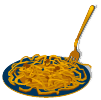 tosafot (pl.), side dishes. Persian green rice is cooked with fresh chopped herbs. The Arab mejadra is cooked rice and lentils.
The North Africa couscous is semolina cooked over broth in a special steamer pot called a couscoussière.
Ptitim is a boiled Israeli pasta and can be baked in a casserole. The Jerusalem kugel is an Ashkenazi dish of baked noodles with caramelized sugar.
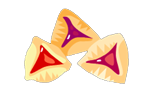 oogot (pl.), cakes. Israelis like home baked cakes. The Ashkenazi babka has halva, chocolate spread, or cinnamon. Apple cake and date cookies are popular to serve with coffee or tea. The sufganiyot (jelly doughnuts) are a traditional Hanukkah dish filled with strawberry jelly.
The Turkish Baklava is a phyllo pastry filled with nuts and sweetened with syrup. Hamantashen (oznei Haman) are triangular poppy seed cookies that are eaten on Purim.
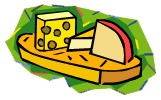 mootzarey halav (pl.), dairy products. Soft white cheese (gvina levana), is sold by its fat content from 5% to 9%. It is spread on bread or crackers and used in cheese cakes. The Middle East labaneh is a yoghurt-based white cheese and is eaten with za'atar or olive oil.
Two of the most popular cheeses are Zfat cheese, a white cheese in brine, similar to feta, and the Bulgarian cheese. Dairy products such as milk and cheese are served at the traditional Shavuot meal.
 lehamim (pl.), breads. The Ashkenazi challah bread is served on the Sabbath and Rosh Hashana and is an egg-enriched braided bread.
Yemenite Jews make jachnun which is oil-brushed, thin rolled dough, cooked overnight. They also serve Malawach which is cooked flat in a frying pan. The Mediterranean pita bread is a pocket of bread usually stuffed with falafel, salads, tehina and hummus. It is also used to dip in salads. The Matza is unleavened bread that is eaten on Passover.
 shtiyot (pl.), drinks. Israel has a strong coffee drinking culture and the most popular is instant coffee (nes kafe). Other drinks include espresso and Turkish coffee.
Tea is prepared Russian-style with sugar, with lemon or milk, or in the Middle Eastern-style with mint (nana).
Malt beer (bira shehora), is a non-alcoholic Israeli beer. Israelis drink about 6.5 liters of wine per person per year, usually on the Sabbath and other holidays.
|